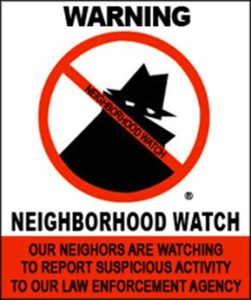What is Neighborhood Watch?
 Neighborhood Watch is a crime prevention program that enlists the active participation of residents in cooperation with law enforcement to reduce crime, solve problems, and improve the quality of life in your area. In it, you will get to know and work with your neighbors, and learn how to:
Neighborhood Watch is a crime prevention program that enlists the active participation of residents in cooperation with law enforcement to reduce crime, solve problems, and improve the quality of life in your area. In it, you will get to know and work with your neighbors, and learn how to:
Recognize suspicious activity and report crimes.
- Protect yourself, your family, and your property,
- Protect your neighbors, their family and property.
- Work together with the San Luis Police Department to identify problems and crimes in your area.
Decades ago, crime rates across the U.S. increased at an alarming pace. Citizens and law enforcement agencies focused on developing crime prevention programs to help reduce this growing trend. In 1972 The National Sheriff’s Association organized the National Neighborhood Watch Program. This pilot program was funded by the Law Enforcement Assistance Administration of the U.S. Department of Justice and was designed to enlist the participation of citizens with law enforcement to help reduce and prevent crime. Since then, Neighborhood Watch has become one of the most effective means of fighting crime in our communities. This is because you and your neighbors are the ones who really know what is going on in your area, most likely to be the first to see a crime and call for help, and are in the best position to:
- Report code violations, unsafe street conditions, etc. that degrade the quality of life in your area,
- Take property owners to small claims court to abate nuisances,
- Keep your block clean and free of graffiti, and
- Provide a safe environment for your children.
Block Watch
The Block Watch program, also known as Neighborhood Watch, is a program that encourages neighbors to watch out for one another. This program promotes active participation by residents, in partnership with the police, to reduce crime and improve the quality of life in your neighborhood. Block Watch works best when neighbors work together to identify, deter, and report crimes. We encourage you to be a good witness and refrain from actually intervening during in-progress criminal activity. The Block Watch program is a basic Neighborhood Watch program confined to 1 or 2 streets within a neighborhood. Several times, this is the beginning of a larger neighborhood watch program
Plan the First Meeting
Make a social media page for your group. This can help you disseminate information, count the number of people attending, and make people aware of changes as they arise. Once you know how many people to anticipate at the first meeting, you can decide on a location for the event. Plan to serve snacks and have an agenda. This agenda may include:
- Introduction: Before the meeting can proceed, have everyone who attends introduce themselves and share at least one story or concern they have about problems in the neighborhood.
- Discussion of the problems in the neighborhood: Make a list of incidents and problems. Analyze the problems for patterns.
- Recruit people to positions of responsibility within the group: Ask people to volunteer for Block Captains and the advisory board.
- Brainstorming: Generate ideas to address the problems that you’ve identified. Your law enforcement contact will play an important role during this portion of the meeting.
- Develop an action plan: Once your brainstorming session is over, developing a plan of action will help ensure that everyone who attends the meeting feels like the meeting has achieved a goal.
- Establish a plan for the next meeting: Know what you want to discuss at the next meeting. Having a list will help ensure that nothing is forgotten.
When the meeting is over, send minutes to the group as a reminder of any commitments they may have made.
Organizing the Group
Most crime prevention groups need leadership and a clear structure in order to stay organized. The start-up committee or advisory board and law enforcement liaisons are generally at the head of the group. Block captains may be assigned to each block. Block captains are responsible for ensuring information is disseminated to other on their block. They also play a role in the coordination of Neighborhood Watch efforts.
Once the structure of the group has been determined, establishing a phone tree can help the group communicate in the event of an emergency. In a phone tree, every person is assigned to several other people in the group. When information is being passed around to other members of the group, the person at the head of the phone tree contacts the people that they are in charge of calling, and those people contact the members of the group they have been assigned to reach out to, and so on. Set up drills to practice the phone tree so that everyone is prepared in the event of an emergency.
Building Relationships with Law Enforcement
The primary function of a crime prevention group is to report crimes, so building a relationship with law enforcement is a critical part of the success of any Neighborhood Watch program. Establishing a specific person from the Neighborhood Watch group to be in charge of communication with the police is a good first step.
This person will be in charge of coordinating with law enforcement, ensuring that the liaison knows when the meetings are taking place and scheduling upcoming police training. Inviting at least one police officer to each meeting is an excellent way to establish this relationship. There may not always be a police officer at every meeting, but it’s important to keep the invitation standing.
Your San Luis Police Department Neighborhood Watch coordinator:

